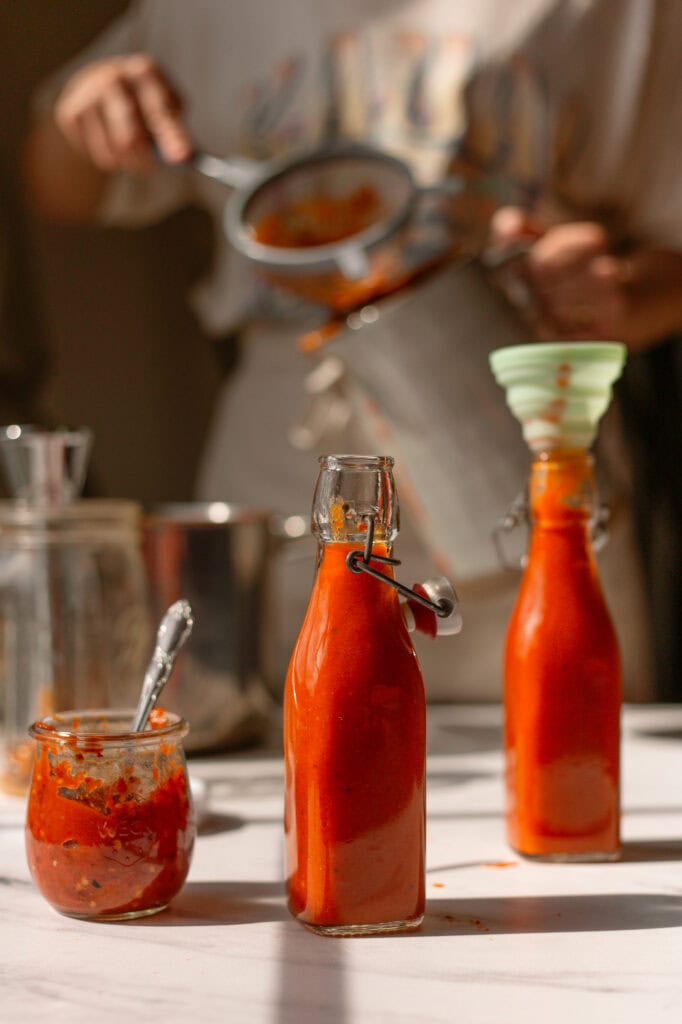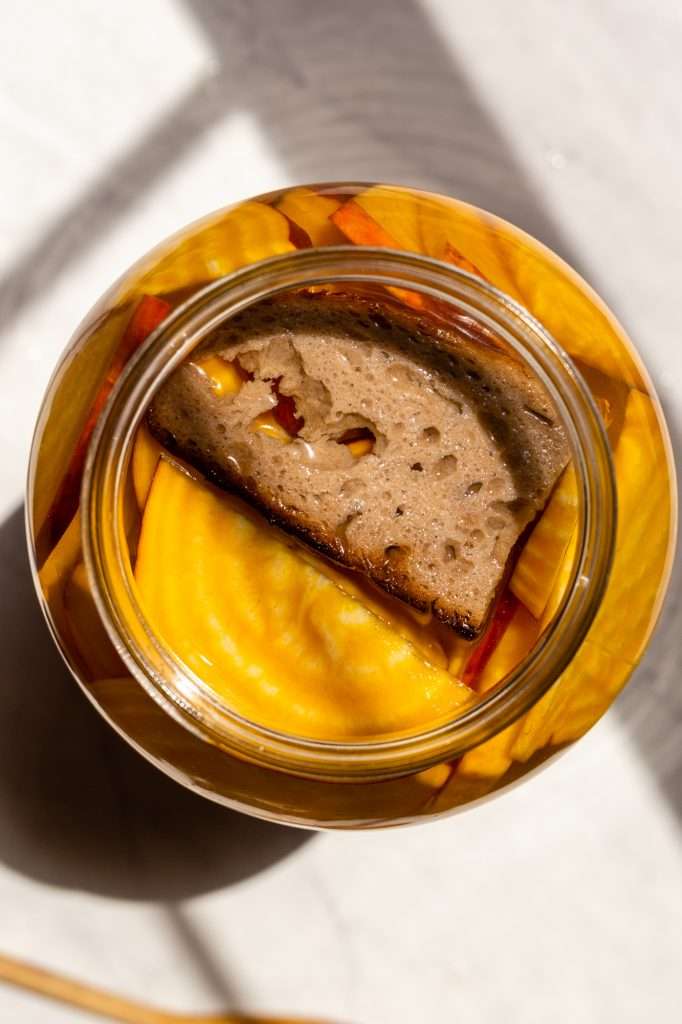How to Feed a Sourdough Starter Rye Flour
When it comes to sourdough, everyone likes to focus on the wild yeasts, but a sourdough starter isn’t all yeast; it’s a mix of yeasts, lactic acid-producing bacteria, and acetic acid-producing bacteria.
In wild sourdough starters, yeasts ferment wheat carbohydrates into alcohol and carbon dioxide. Then, bacteria in the sourdough starter metabolize the alcohols produced by the yeasts into acetaldehyde and then into acetic acid… making it sour.
There are many ways to feed a sourdough starter, and no one way is “correct.” Sourdough starters can be thicker and drier or thinner and more hydrated. You can also use any flour to feed a sourdough starter, but here we will focus on using rye flour.
Rye Flour Sourdough Starter
Sourdough is fascinating because so many different types of microbial metabolism and fermentation are happening all at once. Yeasts make bubbles and visible expansion in a starter, but bacteria make all the flavor.
When more good bacteria are present, they can help boost yeast populations by feeding them usable acids and eliminating waste products (alcohol). In rye flour starters, there is a lot more activity because rye flour is full of the fermentable sugar, fructan.
I’m sure you’ve heard the phrase “discard and feed.” The point of discarding and feeding your sourdough starter is to replenish the microbe’s food source so that the accumulation of waste products does not kill the yeast and bacteria.

Ingredients and Tools to Make Sprouted Rye Sourdough Starter
- Flour: I’ve used many flours to make a sourdough starter. For this recipe, we will use organic sprouted rye flour. The type of flour you use will influence the flour-to-water ratio you should use. Whole grain flour, especially sprouted flour, works well with a 1:2 flour-to-water ratio. White flour, like bread flour and all-purpose, work best between a 1:1 and 2:1 flour-to-water ratio.
- Water: Filtered water is best, but you can use tap water if you think you have good tap water. I use tap water that has been filtered through our water filter pitcher.
- Glass Jars and Cheesecloth: I like to use a glass weck jar for my starter. The mixture needs access to air to grow well, so you can use the glass weck jar lid without sealing it, or something like cheesecloth with a rubber band.
- Kitchen Scale: If you frequent our blog, you should already have one of these on hand. You can find a good kitchen scale option HERE.
- Environment: Temperature is important when it comes to growing healthy yeast and bacteria in a sourdough starter. Your kitchen temperature should be between 60-80 degrees F. Colder temperatures mean slower growth.

How to Feed a Sourdough Starter (thicker, dry, that holds a rise)
So many people email me saying things like, “I fed my starter 8 hours ago, and I see bubbles, but it didn’t rise.”
It did rise; it just fell back down.
If you want to feed your starter before bed or work and see it 8 hours later, still risen and bubbly, you need to make a thicker starter. If you want to snap pics of your starter and expect it to look like the ones on Pinterest and Instagram, you need to make it thicker.
You can feed a 1:1 ratio of sprouted rye flour to water for a thick rye flour starter. So, for example, that would be 50 grams of rye flour, 50 grams of water, and 50 grams of established starter. It will be very thick and may dry out a little on the top, but it will hold a rise you can see.

Making a Rye Flour Sourdough Starter
The feeding ratio is adjustable in these instructions. I suggest following the 1:2 flour to water ratio for the first 7 days; then you can adjust to a thicker starter that holds a “photo-worthy” rise longer.
Step One (Day 1)
- In a bowl combine: 50 grams of organic sprouted rye flour and 100 grams of water
- Use a spatula to combine the flour and water. Stir until there are no clumps and the mixture is smooth.
- Scoop the mixture into a clean glass jar.
- loosely set a lid on the top or secure a breathable covering to the jar (i.e. cheesecloth) and leave the mixture on the counter for 24 hours.
Step Two (Day 2)
- Stir sourdough starter mixture.
- Add in 50 grams of organic sprouted rye flour
- Add 100 grams of water.
- Mix and scrape down the sides. Replace a breathable lid. Leave the mixture on the counter for 24 hours.
Step Three (Days 3-7, Feeding and Discarding)
- To a clean bowl, add: 50 grams of sourdough starter mixture from day 2, 50 grams of organic sprouted rye flour, and 100 grams of water
- Stir until evenly combined, and scoop into a clean jar.
- Replace the breathable lid and allow it to ferment for 24 hours.
- Discard any remaining original starter mixture. Or find fun ways to use sourdough starter discard here.
- Repeat every 24 hours through day 7.
After day 7, to keep your starter active and to make starter suitable for baking, use the following ratios for feeding: 10% starter, 50% flour, 40% water. (example: you need 200 grams of starter for a recipe, so you want to make 250 grams of starter, in order to have some left to feed. You will mix 25 grams of starter, 125 grams of flour, and 100 grams water)

Things to Make with Your Rye Flour Sourdough Starter
Print
How to Make Rye Flour Sourdough Starter
Learn how to make a rye flour sourdough starter. A sourdough rye starter is simple to make, and in just seven days, you’ll have a healthy sourdough starter for baking flavorful, naturally leavened bread!
- Prep: 20 minutes
- Total Time: 168 hours 20 minutes
Ingredients
- Organic Sprouted Rye Flour
- Water
Instructions
- The feeding ratio is adjustable in these instructions. I suggest following the 1:2 ratio for the first 7 days; then you can adjust to a thicker starter that holds a “photo-worthy” rise longer. Please read the blog post above this recipe for more on this.
- Step One (Day 1) In a bowl combine 50 grams of organic sprouted rye flour and 100 grams of water.
- Use a spatula to combine the flour and water. Stir until there are no clumps and the mixture is smooth.
- Scoop the mixture into a clean glass jar.
- Loosely set a lid on the top or secure a breathable covering to the jar (i.e. cheesecloth) and leave the mixture on the counter for 24 hours.
- Step Two (Day 2) Stir sourdough starter mixture.
- Add 50 grams of organic sprouted rye flour and 100 grams of water to the starter mixture in the jar. Mix and scrape down the sides.
- Replace a breathable lid. Leave the mixture on the counter for 24 hours.
- Step Three (Days 3-7, Feeding and Discarding) to a clean bowl add 50 grams sourdough starter mixture from the previous day, 50 grams of organic sprouted rye flour and 100 grams of water
- Stir until evenly combined, and scoop into a clean jar.
- Replace the breathable lid and allow it to ferment for 24 hours.
- Discard any remaining original starter mixture. Or you can find fun ways to use sourdough starter discard here.
- Repeat steps 9 through 12 every 24 hours until you reach 7 days. At this point, it should be bubbly.
- (The Night Before Baking) Feed your starter 8 hours before you plan to make bread dough.
- To keep your starter active and to make starter suitable for baking, use the following ratios for feeding: 10% starter, 50% flour, 40% water. (example: you need 200 grams of starter for a recipe, so you want to make 250 grams of starter, so you have some left to feed. You will mix 25 grams of starter, 125 grams of flour, and 100 grams water); These amounts work for most flour, but add a little more water if it’s too dry. Starters are forgiving.
- (Baking Day) Perform a float test by dropping a teaspoon of starter into a cup of room-temperature water. If it floats, it’s ready for use. If your starter does not float, continue to feed and discard until it passes the float test.
- If your starter passed the float test, put some starter aside to continue feeding. Use the rest of the starter for your baking recipe.
- Again, to keep your starter active and to make starter suitable for baking, use the following ratios for feeding: 10% starter, 50% flour, 40% water. These amounts work for most flour, but add a little more water if it’s too dry. Starters are forgiving.
Notes
- This recipe is formulated using organic sprouted rye flour. If you use a different type of flour, your starter will be a different consistency and texture. This recipe should work well with regular rye flour also.
- The type of flour you use will influence the flour-to-water ratio you should use. Whole grain flour, especially sprouted flour, works well with a 1:2 flour-to-water ratio. White flour like bread flour and all-purpose work best with a ratio between 1:1 and 2:1 flour to water.
- You may notice some early watery separation. This is normal and just means you need to adjust the flour-to-water ratio. Add more flour to your feedings to thicken the starter




















Hi Kaitlyn,
I just stumbled on your website and am obsessed! I was recently diagnosed with Dysbiosis and Candida, and I’m doing everything to change that and my microbiome.
By any chance do you have a video of making your sourdough starters?
Thank you!
Linda
Right now the only video content we have is on our Instagram. We also teach via video in The Cultured Guru School of Fermentation
Hi Kaitlyn, I’m in the process of fermenting your sauerkraut right now and am thinking of making your sourdough starter as well. In this blog you say, “to make a sourdough starter with sauerkraut brine, simply follow the directions in the recipe, but add in 2 tablespoons of sauerkraut on the first day.” Am I adding the actual kraut or the brine of the kraut?
Thank you,
Jacoba
Just add the brine
Hi Kaitlyn,
What do you do if you forget to feed and discard one day and or feed to bake but are unable to bake the next morning?
Thank you.
feed it as soon as you remember and you can pop it in the fridge until you’re ready to use it again.
Thank you so much for your reply Kaitlynn.
Hi Kaitlynn! Great recipe. Making this now, but I was wondering if I run out of rye flour to feed my starter down the line, can I start feeding this starter with high-protein flour just using a different ratio? And when it comes time to bake, I can use a rye starter to bake a loaf of “white” bread (all-purpose, high protein, blend of flours…) right? Basically, you aren’t tied to the type of flour you use when you first begin your starter for the rest of the feedings and when baking, correct?
you can feed your starter almost any wheat or grain flour you want. and you can switch it whenever. Different flours absorb different amounts of water, so you may have to adjust the flour or water a bit to get it the right thickness. Starters are super forgiving though so it’s fine if its too runny one day and way thicker the next. You can also use any kind of starter to bake any kind of bread. I use a rye starter in bread flour breads all the time.